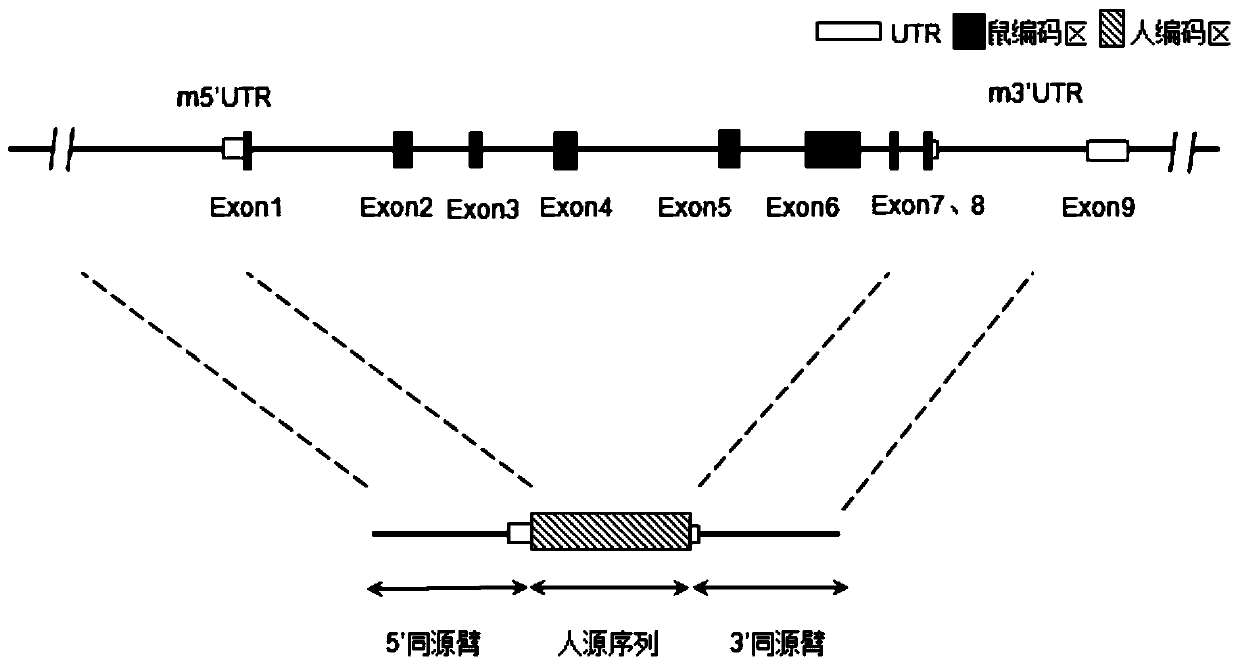Construction method of humanized cytokine CSF1 gene modified-non-human animal and application
A non-human animal, genetic modification technology, applied in the direction of chemical instruments and methods, biochemical equipment and methods, and other methods of inserting foreign genetic materials, which can solve problems such as genetic complexity
- Summary
- Abstract
- Description
- Claims
- Application Information
AI Technical Summary
Problems solved by technology
Method used
Image
Examples
Embodiment 1
[0168] Example 1 CSF1 Gene Humanized Mice
[0169] Mouse CSF1 gene (NCBI Gene ID: 12977, Primary source: MGI: 1339753, UniProtID: P07141) (based on the transcript of NM_007778.4→NP_031804.3, its mRNA sequence is shown in SEQ ID NO: 1, the corresponding amino acid The sequence is shown in SEQ ID NO: 2) and human CSF1 gene (NCBI Gene ID: 1435, Primarysource: HGNC: 2432, UniProt ID: P09603) (based on the transcript of NM_000757.5 → NP_000748.3, its mRNA sequence is shown in SEQ ID NO: 3, and the corresponding amino acid sequence is shown in SEQ ID NO: 4) The comparison diagram is shown in figure 1 shown.
[0170] In order to achieve the purpose of the present invention, the gene sequence encoding human CSF1 protein can be introduced into the endogenous mouse CSF1 locus, so that the mouse expresses human CSF1 protein. For example, mouse cells can be modified by gene editing technology, at the start codon of endogenous mouse CSF1 (ATG), a coding sequence that can express human CS...
Embodiment 2
[0223] Example 2 Generation of CSF1 and humanized cytokine mice with severe immunodeficiency
[0224] In order to generate mice that contain human CSF1 and have severe immunodeficiency, the CSF1 humanized mouse heterozygote prepared in Example 1 can be mated with B-NDG mice or fertilized in vitro (IVF). The offspring can be screened with a certain probability to obtain heterozygous mice with CSF1 humanization and IL-2Rγ chain deletion, and then cross the heterozygotes to obtain homozygotes with double or multiple genes.
[0225] In the microinjection process in Example 1, the fertilized egg cells of B-NDG mice were used instead of NOD / scid mice to directly obtain B-NDG mice expressing human CSF1 protein.
[0226] The expression of human CSF1 protein in positive mice can be confirmed by conventional detection methods, such as ELISA method and the like. Choose one B-NDG mouse and one B-NDG-hCSF1 homozygous mouse, inject 20μg / 200μL LPS intraperitoneally, take the spleen after 2 ...
Embodiment 3
[0227] Embodiment 3 Contains double gene or multigene humanized mouse of human CSF1
[0228]Double-humanized or multiple-humanized mouse models can also be prepared by using the method or the prepared CSF1 mice. For example, in the aforementioned Example 1, the fertilized egg cells used in the microinjection and embryo transfer process were selected from fertilized egg cells derived from other genetically modified mice, for example, the fertilized egg cells of IL3 or IL15 or CSF2 gene humanized mice were selected using this Methods Through gene editing, a humanized mouse model with double gene modification of IL3 or IL15 or CSF2 and CSF1 can be obtained.
[0229] The homozygous or heterozygous CSF1 mice obtained by this method are mated or fertilized in vitro with other genetically modified homozygous or heterozygous mice, and the offspring are screened. According to the Mendelian inheritance law, there is a certain probability of obtaining CSF1 humanization Digene or polygen...
PUM
 Login to View More
Login to View More Abstract
Description
Claims
Application Information
 Login to View More
Login to View More - R&D Engineer
- R&D Manager
- IP Professional
- Industry Leading Data Capabilities
- Powerful AI technology
- Patent DNA Extraction
Browse by: Latest US Patents, China's latest patents, Technical Efficacy Thesaurus, Application Domain, Technology Topic, Popular Technical Reports.
© 2024 PatSnap. All rights reserved.Legal|Privacy policy|Modern Slavery Act Transparency Statement|Sitemap|About US| Contact US: help@patsnap.com










